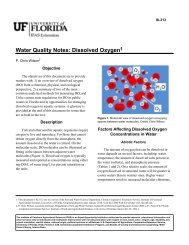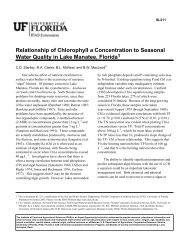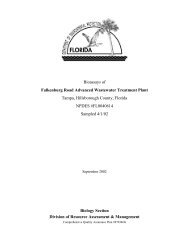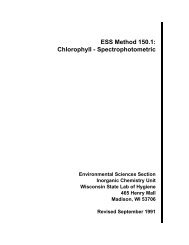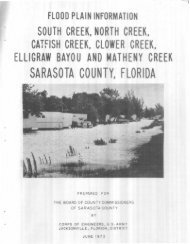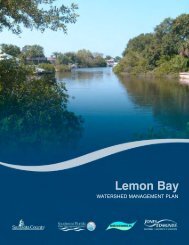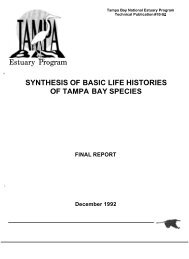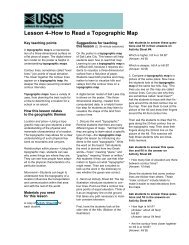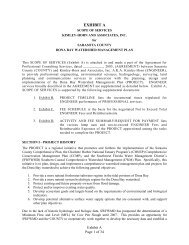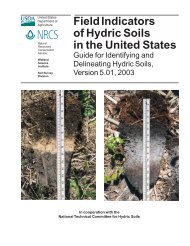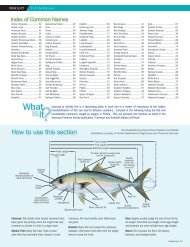Peace and Myakka River Water Quality Summary 2002 - Southwest ...
Peace and Myakka River Water Quality Summary 2002 - Southwest ...
Peace and Myakka River Water Quality Summary 2002 - Southwest ...
Create successful ePaper yourself
Turn your PDF publications into a flip-book with our unique Google optimized e-Paper software.
4.1 PHYSICAL PARAMETERSNear-Surface SalinityAnnual near-surface salinity patterns at the seven monitoring stations during wateryears 1994 – 2000 are summarized, in percentile form, in Appendix B.The most upstream stations in both river systems (CH-001 in the tidal <strong>Myakka</strong> <strong>and</strong> CH-029 in the tidal <strong>Peace</strong>) were located in oligohaline areas, with median salinities 20 ppt).Median near-surface salinities at the remaining stations were generally mesohaline,ranging between 10 <strong>and</strong> 25 ppt. Stations CH-002 (<strong>Myakka</strong>) <strong>and</strong> CH-004 (<strong>Peace</strong>)exhibited similar median values, of between 10 <strong>and</strong> 22 ppt. Stations CH-02B (<strong>Myakka</strong>)<strong>and</strong> CH-05B also exhibited similar median values, between 13 <strong>and</strong> 24 ppt. Highestmedian salinities (18–26 ppt) occurred at station CH-005, near the mouth of the <strong>Peace</strong><strong>River</strong>.The maximum salinity value shown in Appendix B (44.95 ppt), a near-surface valuereported from station CH-005, apparently reflects an instrument malfunction ortypographic error, <strong>and</strong> has been removed from the District database (C. Anastasiou,personal communication).Near-Surface ColorNatural water color, produced as a result of decomposition of leaf litter <strong>and</strong> otherrefractory organic matter, has been shown to be an important source of light attenuationin the <strong>Peace</strong> <strong>and</strong> <strong>Myakka</strong> river systems <strong>and</strong> portions of Charlotte Harbor (McPherson<strong>and</strong> Miller 1987).Among the stations sampled during water years 1994-2000, median near-surface colorlevels varied inversely with median near-surface salinities. Color levels were quite highat the most upstream stations (CH-001 <strong>and</strong> CH-029), fell by about 50% between thosestations <strong>and</strong> the next downstream sampling locations (CH-002 <strong>and</strong> CH-004), <strong>and</strong>declined another 20-40% at the highest-salinity stations (CH-02B, CH-05B, <strong>and</strong> CH-005) (Appendix B).Color levels in estuaries are affected by a variety of physical <strong>and</strong> chemical processes.The simplest physical process is dilution, which occurs when highly colored river watermixes with sea water containing much lower concentrations of the dissolved <strong>and</strong>colloidal humic acids <strong>and</strong> other compounds that contribute to water color. Humicmaterials are also removed from the water column through two physical-chemicalprocesses — flocculation <strong>and</strong> adsorption — whose rates increase when the materialsare transported from fresh to more saline waters. In estuaries, flocculation of humicacid colloids reportedly occurs preferentially at salinities between 0 <strong>and</strong> 5 ppt (Day et al.1989).52



